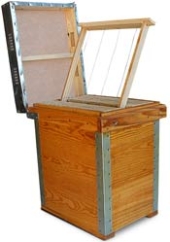Hi Steve,
Welcome...

First, I am hoping that a moderator will move this to a forum that will see more traction. This should be in green woodworking...I think?
Coopering a barrel of any size will be a matter of more than just "one set angle." This is much an art as it is a "geometry exercise." As you have noted...staves are of different widths...and...tapered to facilitate the shape that is a "barrel." and like buckets, tubes, sinks, troughs, and related containers the angles can vary greatly...
They build them that way for more strength and economy so more wood can be used with less scrap.
Actually they build them that way for strength...and "economy" is just a fringe perk to the process..."Coopers" are frugal folk to say the least...
So my question is will they still use the 12 degree angle or do the modify the angle for each piece.
They are custom to each stave and following a "format angle" that the Cooper has selected for the give shape (aka curve) of the container. If building something like an wood form of 風呂 ofuro( Japanese soaking tub) you may find a more consistent geometry to follow in some of the designs...However, even these Ki oke furo
木桶風呂 (Wood Tub Bath) or teppōburo 鉄砲風 (Gun Bath) are as much art and artistry of technique as they are any "set geometry" per se...
I would imagine that it would be to time consuming in a commercial operation to keep changing their machine jigs. So how does one figure out the angle if the number of pieces change when the diameter of the barrel stays the same...
Finding and learning directly from an experience cooper, and/or a lot of "experimenting" with your own techniques of green woodworking...

There is some pretty good (and not so good) info out on the "web" covering this subject...
Good Luck,
j
here is a link to the first class I found...
Coopering Buckets
Coopering Barrels








